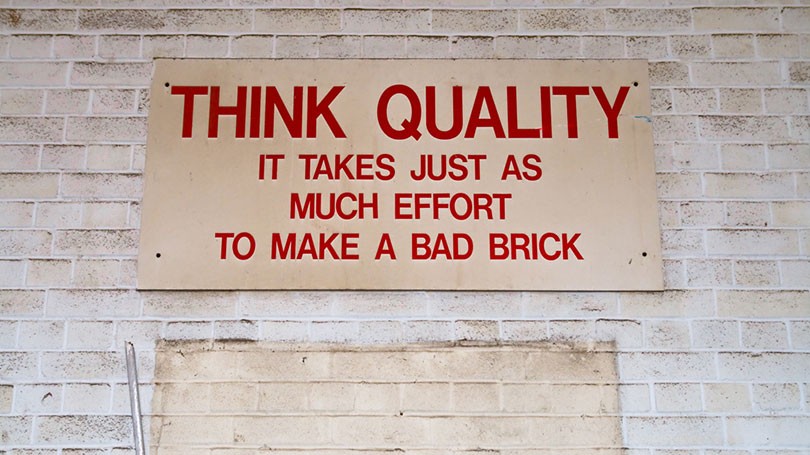6 Common Sense Ideas for Increasing Quality of Hire
Every company wants to increase quality of hire. Since typically most top prospects are not looking, it’s important that companies design their hiring process to appeal to these passive candidates. This reengineering effort starts by benchmarking how you promote and move people internally and applying that to your external hiring process.
Consider these observations:
- We promote people we personally know based on their past performance and future potential, but when we hire people we don’t know, we require they have an overdose of skills and experiences. This is an unnecessary bottleneck that dramatically reduces the pool of high-caliber candidates.
- In the early stages of their careers, the best people – those who are assigned the most complex and important projects – tend to be lighter on skills and experiences than their peers. This is why they’re considered the best – they accomplish more with less. This same idea can be adopted for hiring people from the outside.
- When changing positions, the best active and passive candidates always make the decision based on the job that offers the most personal satisfaction, the biggest challenge and the most upside opportunity. However, when we hire people from the outside we assume they have an economic reason to switch jobs and it’s okay to offer them lateral transfers as long as we pay. Very few high-caliber candidates meet this unwarranted filter.
- When we hire people from the outside we expect the best to take less than they’re worth, force them to endure a demeaning application and interviewing process, and expect them to take jobs below their capability. This point alone suggests a complete redesign of the hiring process is justified for companies that want to improve quality of hire, not just fill jobs with the best person who applies.
Given the indisputable nature of these facts, why not hire people we don’t know, using the same sourcing, interviewing and hiring process for people we do know.
Here’s the basic idea:
A performance-based management approach for increasing quality of hire
1. Focus on the intensity of experience and the person’s actual past performance to assess their ability.
The internal hiring process is quite predictable in determining if someone will be successful since we know the person’s reliability, past performance, ability to learn and adapt, how the person fits within the culture, and how well the he/she works on teams. There is no reason these same criteria can’t be applied for hiring people whom we don’t know. I call this process Performance-based Hiring.
2. Pull the performance management process into the hiring process.
It seems rather odd that we define the work the person is expected to do after the person is hired. Most companies have a performance management system describing the major objectives each employee is expected to achieve. Why not use this same approach when opening up a new job or replacing someone? Start by asking the hiring manager to define the top 2-3 performance objectives for the position and why a top, fully-employed person would consider the job a career move. This then becomes the basis for recruitment advertising, sourcing and screening. Here’s a example of this type of posting.
3. Use a performance-based job description to define the work rather than defining the person doing the work.
When opening up the requisition, stop thinking what the new person must have in terms of skills and experiences. Instead figure out what the person must do in order to be considered a great hire. Start with the top 2-3 performance objectives from point 2 and then define the critical sub-tasks needed to accomplish the main tasks. For example, if an engineer needs to complete the design of a new product in the first year, some critical sub-tasks would be to complete the product spec with marketing in 60 days and test alternate design concepts 90 days later.
4. Conduct a pre-hire performance review to replace the traditional interview.
The key to this is to ask candidates to give detailed examples of comparable accomplishments for each of the performance objectives listed in the performance-based job description. Here’s a post describing exactly how this type of performance-based interview is conducted.
5. Offer a career move, not a lateral transfer.
As long as the person has a track record of handling bigger assignments and everything else fits, the person is someone you should seriously consider hiring. Use the gap between what the person has done and will be doing to demonstrate the learning and growth opportunity. A gap of around 15-20% is usually sufficient. You might need to modify the job a bit to achieve this. Consider both stretch (bigger job, more impact) and growth (more future opportunities) to create this gap.
6. Use the performance-based job description as the foundation of the on-boarding program.
Clarify the performance-based job description during the first week on the job to ensure expectations are understood. Supplement any coaching requirements with formal training to ensure the person is given every chance to succeed. Since it represents actual job requirements, the performance-based job description is a great tool to manage the person throughout the year.
Google’s Project Oxygen and Gallup’s Q12 demonstrated that clarifying expectations upfront is an essential aspect for maximizing performance and job satisfaction. A preeminent labor attorney from Littler Mendelson demonstrated that Performance-based Hiring process meets all U.S. labor law and is a great means to attract more top performers, including diversity candidates. Companies now successfully use a Performance-based Hiring process for internal moves and promotions. Given all of this it’s hard to argue that the same process shouldn’t be used for external hires. What seems illogical is not using it.
To receive regular updates like this, subscribe to the blog newsletter.
* image by thirtyfootscrew
Topics: Quality of hire Recruiting tips
Related articles




